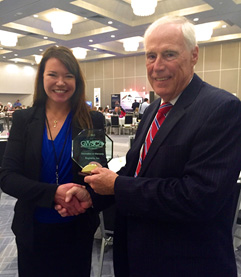.png)
Warranty Innovations goes virtual! The organizers of this year’s Extended Warranty and Service Contract Innovations Conference did a great job pivoting the event to an online format. This was actually my first virtual conference, and it was far more engaging than I had hoped. I really enjoyed seeing so many familiar faces and making new connections via the virtual sessions and chats.
This annual conference draws attendance across a spectrum of industries and, of course, care program solution partners like Registria, one of this year’s sponsors. In the consumer durables and electronics sectors, many of the conference insights this year were centered around digital experiences, accelerated by COVID-19, and confirming what we see with our brand partners and in our personal lives.
It’s no secret that consumer shopping patterns have changed — and that the changes are here to stay. While online shopping has been on the rise for the last decade, 2020 shows an even more dramatic increase. According to eMarketer, eCommerce sales in the US will grow by 18% in 2020, compared to brick-and-mortar sales projections decreasing by 14%. Curbside pickup has also grown in popularity. I personally never used this service before the pandemic, but now I choose to shop with the retailers that have the most advanced app features, including real-time inventory and fast, easy, contactless pickup.
Low inventory due to retooling factories for COVID safety has affected a number of consumer durable industries. Many consumers put their purchases on hold or had to opt for other brands when their preferred brand was out of stock. The unexpected delays and extra burden on consumers undoubtedly caused increased frustration (trust me, I speak from experience on this one).
Another effect of the pandemic is that brands have had to modify their installation and service procedures to protect field service staff as well as homeowners. Brand trust became more imperative and many brands shifted resources to digital onboarding and service methods.
Despite these challenges, protection plan sales have fared quite well. Conference attendees reported:
-
Consumer adaption to digital channels, including for aftermarket sales
-
A more captive audience, looking for trust
-
Increases in attachment and conversion rates
-
Improved renewal rates
These trends and others affecting warranty and service plan strategies were underscored by the panel discussion I moderated, “Value-add Service Contract Benefits to Enhance Consumer Ownership Experience.”
Panelists Michelle Esgar (Panasonic), Steve Gusa (Duke Energy), and Frank McMillan (Ensure Protect) weighed in on several key questions affecting the industry and driving innovation. Highlights from the session are below.
Which trends have changed what consumers do and don’t want from brands?
Michelle: Hyper-personalization. Each customer’s journey with our brand is unique and each customer is at a different point in that journey. Personalizing experiences for each customer is very important, especially during post-purchase when they’ve already bought into your brand.
Steve: Consumers sometimes don’t know exactly what they want but they do know they want control. Brands have to give them different options so they can choose their preference and keep control over their experience.
Frank: Consumers want to know how to get more from the product or service they’ve purchased – how to use, when to use/upgrade/service, where to use, etc. But we have to be wary of information overload, be wary of asking too much. Give them a few options and let them chose the path they’d like.
There’s been a rapid shift to digital, accelerated by the events this year. Where should brands focus?
Steve: As we reflect on the events this year and trends we’re seeing, I have a hard time going back to gain a real understanding of what worked – but I won’t forget what didn’t! The main takeaway, everything will be driven digitally in the future, and quicker than we thought at the beginning of this year or in past years. We knew it was coming, this year forced a lot of hands.
Michelle: We’ve focused on real-time testing, offering a variety of choices, and using technology and data to discover what’s working and what’s not. Then, we double-down on what is working, quickly. We’ve found a lot of value in letting our customers choose what they prefer because then it’s a real choice. You still have to keep the choices focused and limited but we use the power of real, first-party data from our customers.
Frank: Consumers aren’t just speaking to brands with their money anymore; they really care about convenience, value, and experience. All things that digital programs can help brands achieve.
What happens if the service contract and warranty industry doesn’t take action to address real and evolving consumer preferences?
Frank: We work in very specific industries. For bikers and surfers, they need to access support or care on the beach or road, anywhere at any time – and they need to use technology (typically a smartphone) to do so. We need to deliver data-driven service and care experiences anywhere in the world, in real-time, to take care of customers’ real-time needs.
Michelle: In my career, I've never seen a price promotion perform worse than a care promotion – until this year. Consumers are changing their preferences and expect brands to take care of them. We’re betting that by providing great long-term care for the owner, relationship and service will trump any short-term profit that we get from a flash promo.
Knowing who our customers are and making experiences with Panasonic super easy for them is the key for us. We’re no longer concerned about delighting and wowing our customers with every interaction (a CX trend and buzz phrase for years) We’re more concerned with making these experiences organic, easy, and almost an “Invisible Experience” (IX?) – ease of use and automation are key for us.
Steve: Warranty is really becoming total brand support throughout the ownership experience. Service contracts themselves may disappear as subscription models become available where service is simply included by the brand and expected by consumers during the product and ownership experience.
There will be more brands going direct-to-consumer – one lever of which is the care of the owner throughout the ownership experience. Brands like Amazon and Apple have pioneered this space and are “Frienemies.” Apple sells direct-to-consumer and through retail channels but utilizes care programs like Apple Care and other subscriptions to provide direct-to-owner (DTO) value throughout the product lifecycle and ownership experience – driving massive loyalty, repeat purchase, and brand affinity over the lifetime of the consumer. They use technology to accomplish this and keep that invisible experience.
Warranty Innovations: That's a Wrap!
All of this is to say, brands, retailers, everyone is in a race to own the customer relationship. Providing great support and protection through constant communication will be key for brands looking to build those relationships. In all reality, brands will need a true partner or set of partners to get there. Vendors that provide piece mail but not strategic direction will be phased out.
I highly recommend the full panel discussion for more insights. As brands evaluate their existing post-purchase programs with regard to changing consumer preferences, we can all work together to evolve “Extended Warranties and Service Plans” to all-encompassing “Care Plans.” The future lies in caring for product owners throughout the ownership experience – directly, digitally, and personally.

Registria recognized with Innovation in Warranty Award
I am excited to share the news that Registria received the Innovation in Warranty award during the Warranty Chain Management

Service Takes Over: The Big Pivot for Product Brands
The series explores the extended warranty and service market and the new trends brought to light by Registria's newest owner research.





